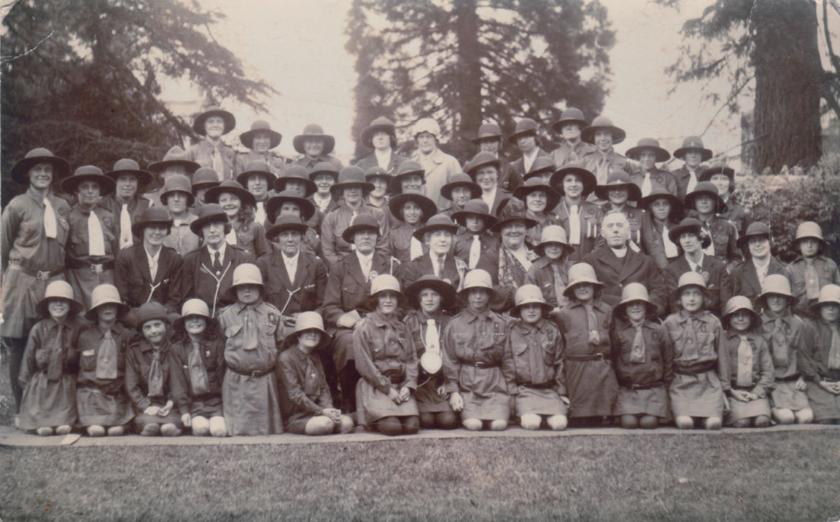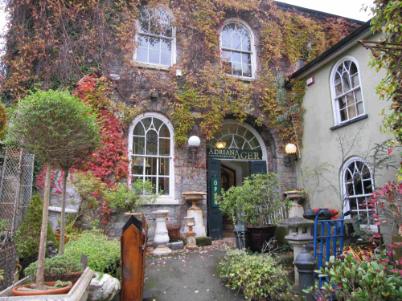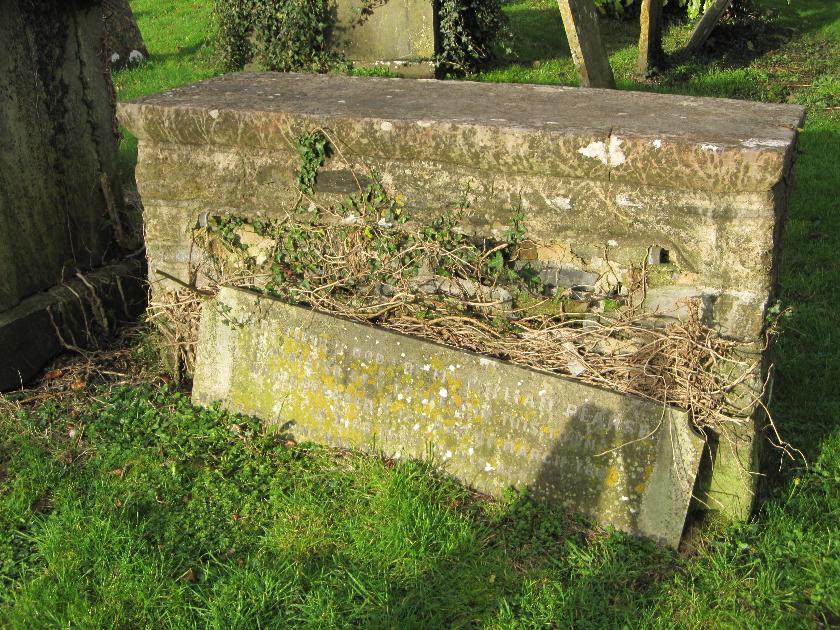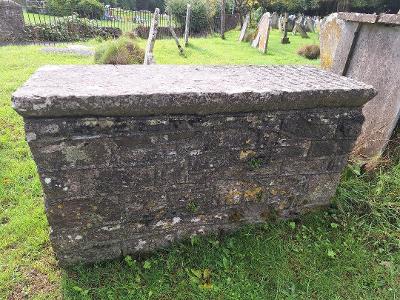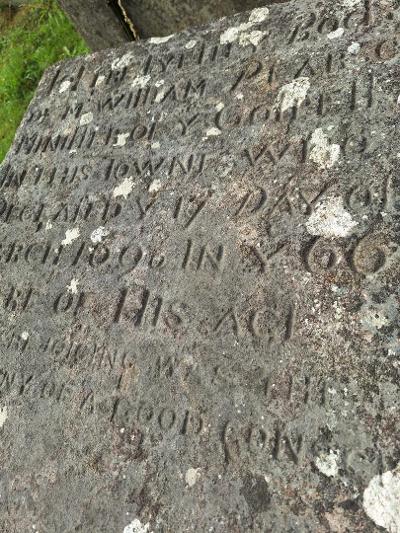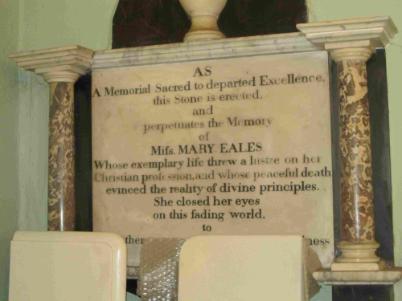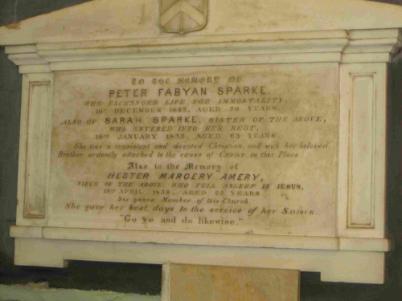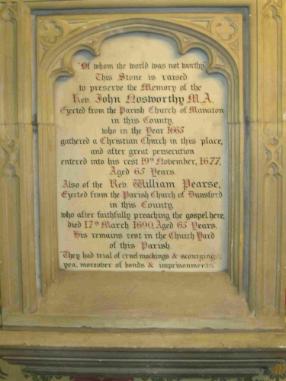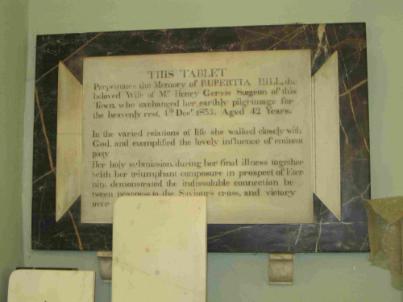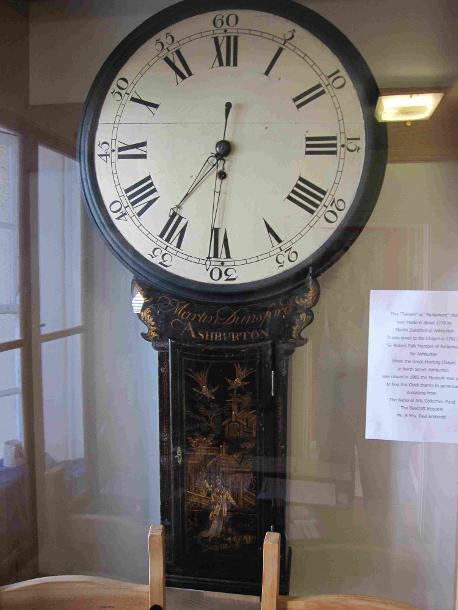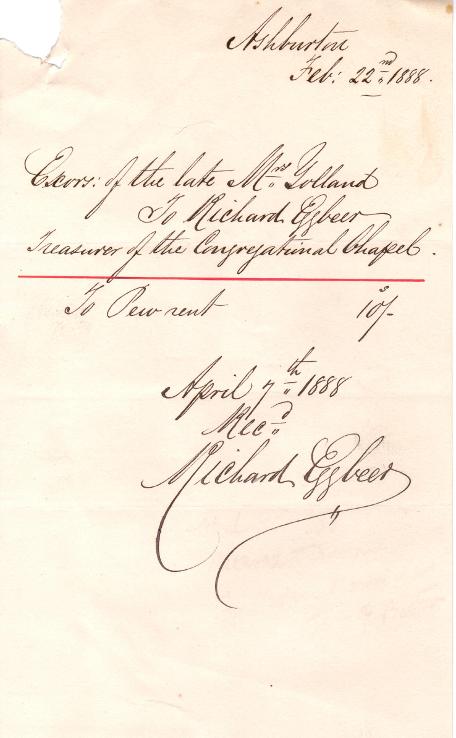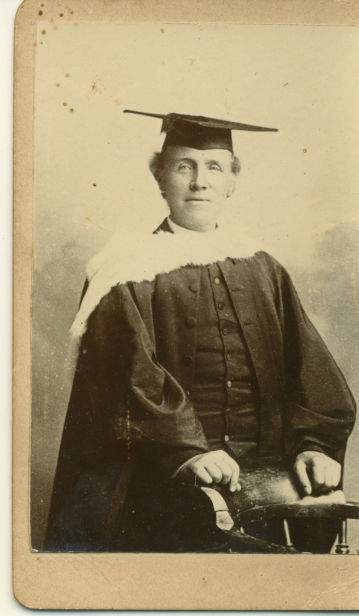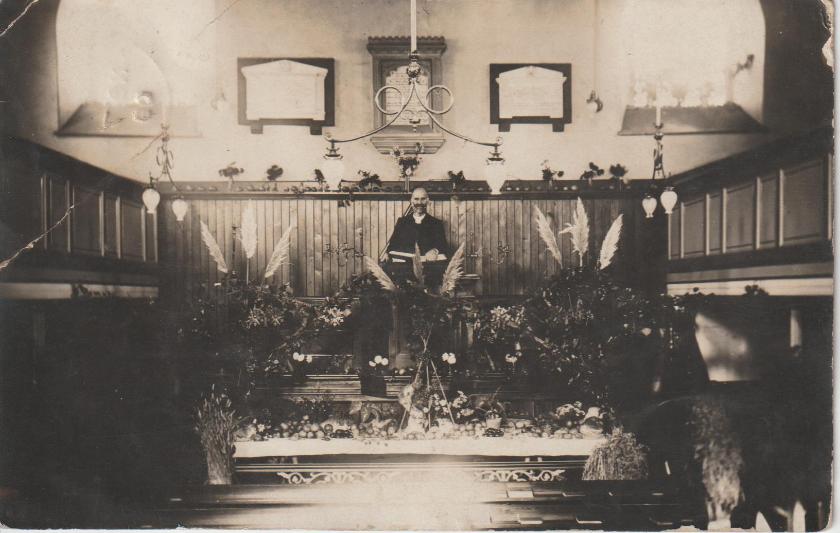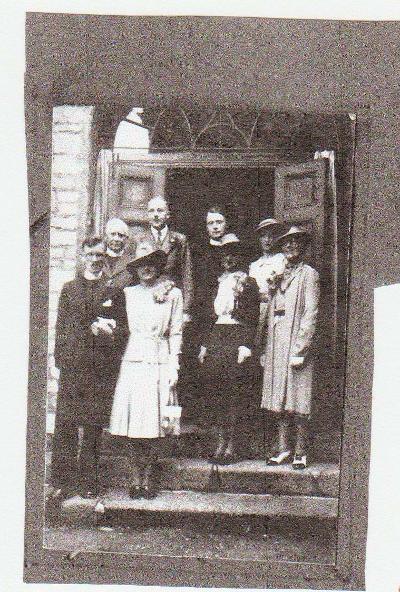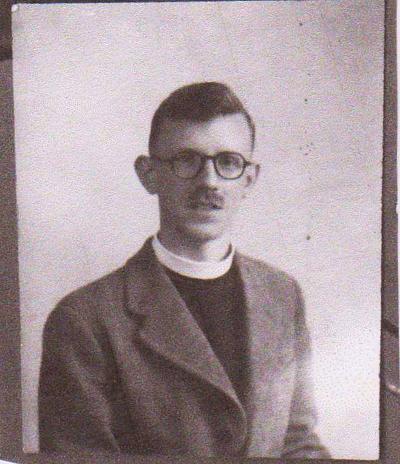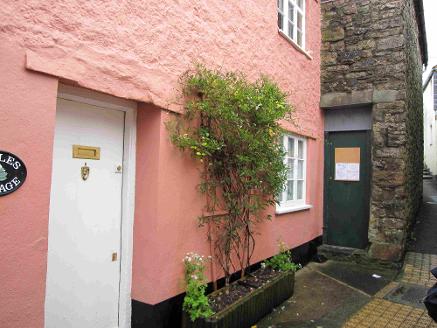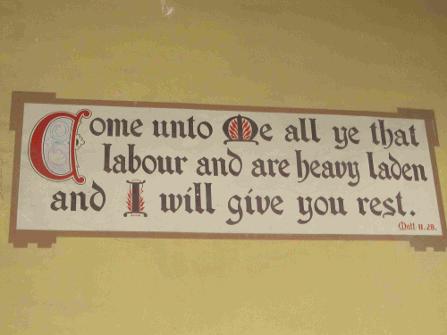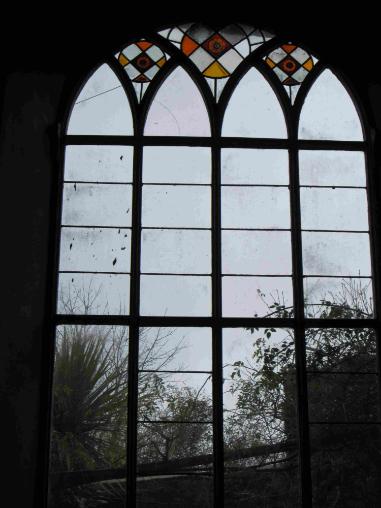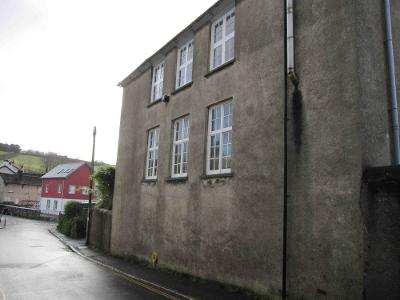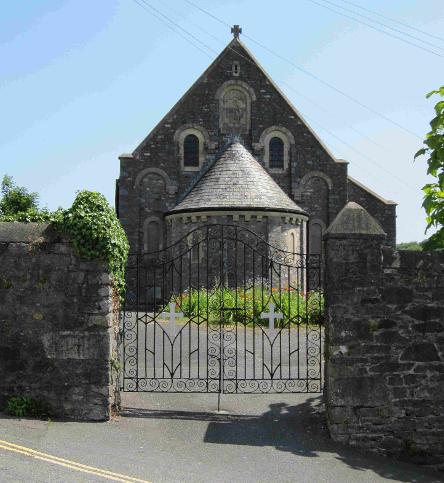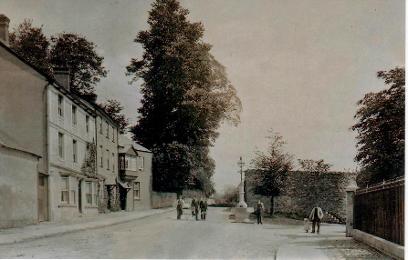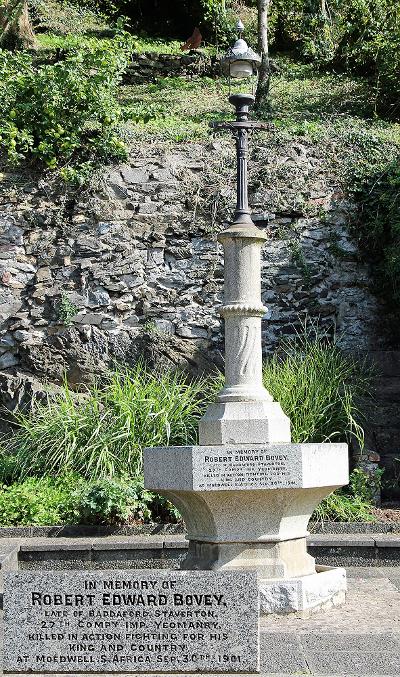Churches and ChapelsSt Andrew's Church and the Wesleyan Chapel are now on a separate submenu
For information on memorials, see the bottom of this page.
'To Ashburton....its a market
town and here are a great many Dissenters and those of the most
considerable persons in the town; there was a Presbiterian, an
Anabaptist and Quakers meeting'
Celia Fiennes. 1689
The Illustrated Journeys of Celia Fiennes
1685-c1712 Ed Christopher Morris, Macdonald and Co London; Webb and
Bower Exeter, 1982, p 200
*******
In 1875 the Western Times published an article on Non-conformity in Devonshire, claiming that in the Record Office in London there was a complete list of those licensed to preach in 1672. Those mentioned in connection with Ashburton are John Syms and Richard Tapper, both down as Presbyterians.
Western Times 5 February 1875 p2 col3
*******
Ashburton clergy in the Universal British Directory of Trade, Commerce and Manufacture, Vol 2, late 1700s:
Rev George Martyn
Rev Jonathan Palk
James Stoat , dissenting minister
Rev John White, Master of the Grammar School
*******
'Exeter, June 21st, 1797
At a meeting of the Western Calvinistic Association, held this day, Resolved, that a Society be formed for the purpose of promoting the knowledge of the gospel of Christ in the counties of Devon and Cornwall...That the Rev. James Stoat, of Ashburton, be appointed Secretary, and Mr William Fabyan, of Ashburton, Treasurer.'
The Evangelical Magazine for 1797, London, p340
*******
In 1841 ministers of all denominations met in Manchester to discuss the Corn Laws.* The Rev W P Davies of Ashburton represented his own congregration and three others in South Devon. 'The working people of Ashburton were half their time unemployed, and in a state of great destitution. '
Report of the Conference of Ministers of all Denominations on the Corn Laws, Manchester 1841
*The Corn Laws, dating from 1804, placed a duty on imported grain. The measures were designed to help landowners, but they had the effect of keeping the price of bread high.
*******
From Kelly's Directory of Devonand Cornwall 1893:
Places of worship.
The Baptist Chapel, Heavyhead Lane, erected 1798. Has 300 sittings.
The Congregational Chapel, North St, erected in 1665. Will seat 600
The Wesleyan Chapel, West St.,erected 1835. Will seat 700
The Brethren have a room in North St. Will seat 150.They also have one near the Railway Station.
From Kelly's Directory of Devonshire 1902:
Places of worship.
St. Andrew's Church, vicar - Rev Richard James Bond
Curate - Rev Arthur Phillip Lancefield
Brethren's room,North St
Brethren's meeting room, near the station
Congregational, North St - Rev Samuel Naish B A
Wesleyan Methodist, West St - Rev John Richard Newall
From Kelly's Directory of Devonshire 1935:
Places of worship.
St. Andrew's Church, vicar - Rev E F Ball M A
Roman Catholic (temporary building) served by priests of Buckfast Abbey
Brethren's room,North St
Congregational, North St - Rev H F Hawkes
Methodist (South Devon Mission) West St - Rev F Knibbs
*******
The old Congregational Chapel in North Street
(also known as 'Great Meeting')
'In the Episcopal Return of Conventicles in 1669 (Tenison MS., 639, p185b) this entry appears:
"Ashberton, at ye house of ye old John Syms: 100 : ye said John Syms a Nonconformist minister. This Conventicle is lately supprest." '
Rev T G Crippen, Congregationalism in Ashburton, Congregational Historical Society Transactions vol 12 no.4, London September 1934, p187ff
According to the Rev. T G Crippen, Sims was the Puritan minister of Dean Prior.
On 22nd March 1672, after the publication of the Declaration of Indulgence, 72 non-conformist ministers in Devon sent a message of thanks to the king. Signature no. 18 was that of William Pearse, no. 20 was John Sims and no.41 was John Nosworthy.
On 11th April 'John Sims, near Ashburton, Devon' was granted a licence as a 'Grall.Pr.Teacher', which was a general licence as a Presbyterian to preach anywhere that was allowed. A week later John Nosworthy, MA, was granted a similar licence. A licence for 'The Schoolhouse at Ashburton in Devon' was applied for but was apparently not issued.
On 25th July 1672 'The house of Richard Sappers at Ashburton in Devon' was granted a licence for Presbyterian meetings. The licence for Richard Tapper on 10th August was probably a correction.
The Rev. Crippen believed that Mr Nosworthy probably used Richard Tapper's house, and that Mr Sims possibly did.
On 28th October 1672 'Thomas Egbeare of ye Congl. way to be Teachr at the house of Gregory Millard of Ashburton in Devon' was granted a licence.
John Fabyan, in his will of 1690, left 30s to 'The poor of Mr Pearse his meeting in Ashburton' and 20s to 'The poor of Mr Palk his meeting in Ashburton.'
Thomas Palk died on 10th June 1693, aged 55.
ibid
Mr. Roger Caunter, an attorney, who was preesent, said, "Sir, keep your place, for you are preaching God's word." Another time...Mr. Stawel entered the town, in his coach, attended by his servants and others with drums, muskets, etc....the two drummers beat their drums, some discharged their guns, others shouted and made loud huzzas...Mr. Nosworthy departed this life Nov. 19 1677....
...it appears that Mr. William Pearse succeeded...Mr. Pearse's tomb yet exists in the churchyard of Ashburton.'
The Congregational Magazine, January 1825, pp 53, 273
Above: The tomb of William Pearse in Ashburton churchyard. 'Here lyeth y body of Mr William Pearse minister of y gospel in this town who deceased y 17th day of March 1690 in y 66 year of his age whose rejoicing was the___________'
My own photograph 2019
'Six times a year the Bailiff came to Stretchleighhouse to warn Mr Pearse and his wife, with his son and daughters, to appear at the Assizes at Exeter, to answer for Riots, Routs, keeping seditious Meetings, and not obeying the Laws...he was impoverish'd, pursu'd, and imprison'd, for no other Crimes than preaching the Gospel of Peace, and endeavouring to help on Souls in the Way to Heaven....He survived the Tribulation of those Days, and saw our Civil and Religious Liberties restored by the happy Revolution: After which, he set up a publick Metting in Ashburton, where he continu'd for the Remainder of his Days. He died March 17. 1690/91, Aetat 65*.'
Edmund Calamy DD, A Continuation of the Account of the Ministers, Lecturers, Masters and Fellows of Colleges, and Schoolmasters, who were Ejected and Silenced after the Restoration of 1660, by or before the Act of Uniformity, London, 1727, p341ff
*Aged 65
'Dr Walk'r is pleased to throw Dirt very plentifully at this good man...'
A letter rebutting the allegations follows, written by Mr Pearse's daughter, Mrs Agnes Pearse, dated February 28, 1717/18, at Ashburton.
ibid p342
John Flavel of Dartmouth, an influential nonconformist and author of six volumes of 'Works', had an immense following during his lifetime. Born circa 1630, he died in June 1691.
Brian H Cosby, John Flavel: Puritan Life and Thought in Stuart England, Plymouth 2014
'The last sermon he preach'd was on the 21st of June 1691, at Ashburton, from I Cor. 10.12 Wherfore let him that standeth take heed lest he fall'
He died on the 26th June. 'His corps was carried from Exeter to Dartmouth, attended by several Ministers, and a great many other Persons of good Quality; abundance of people rode out from Dartmouth, Totness, Newton, Ashburton and other places to meet the corps...'
The whole works of the Reverend John Flavel, London 1701
Mr. Mead succeeds Mr. Pearse, who is then succeeded by Mr.Taylor in 1702*.
Mr. Taylor is followed by: Cornelius Bond (1711)
Nathaniel Cock (1716)
Samuel Wreyford (1741)
Thomas Clark (1761)
George Walters (1763)
James Stoat (1783)
David Parker (1814)
John Kelly (1817)
The Congregational Magazine, January 1825, pp 53, 27*John Taylor according to Rev
T G Crippen, Congregationalism in Ashburton, Congregational Historical
Society Transactions vol 12 no.4, London September 1934, p189ff
The Rev Crippen also has Samuel Staddon or Stoden in 1712.
He says that Mr Kelly left in 1827, after which there was a vacancy for two years.
'The present Independent Chapel, situated in North Street Ashburton, appears from the original trust deed to have been erected in 1739, on the site of a barn which had been converted into a meeting-house for the worship of God as early as 1712, it being so described in a deed of that date...from the deeds, the property appears to have originally belonged to Thomas Glanvill, of Exeter, fuller, and Thomas Sainthill, of Ashburton, clothier, who, November 15th, 1712, conveyed it to one John Comyn.
In 1729, November 7th, John Comyn, of Morchard Bishop, yeoman, conveyed it to Andrew Quick, of Newton St Cyres, esquire, and, January 24th, 1739, Dorothy Quick, of Newton St Cyres, daughter and surviving devisee of A. Quick, conveyed it to John Enty, of Exeter, clerk, and Aaron Tozer, of Exeter, haberdasher....
May 15th, 1739, Messrs Enty and Tozer conveyed the property to thirteen trustees, upon trust, for them to permit the meeting-house (then evidently in course of erection, or re-erection) to be finished and completed, and from completion to suffer and permit the said meeting-house to be used as a free and public meeting-house for the worship of God by Protestant Dissenters, called Presbyterians; and Mr Joseph Cock is mentioned as the then minister.'
Edward Windeatt, Early Nonconformity in Ashburton, Transactions of the Devonshire Association, vol 28, 1896, p236ff
'About the time when this deed was executed the converted barn was enlarged to about double its former size. There was an adjacent barn, the two running side by side, each having a door into Cad Lane. The partition wall was taken down, two pillars being placed to sustain the roof; the two doors gave place to two large windows, the pulpit being between two windows on the north side. The building was square, having no gallery; the centre was occupied by four large family pews. Three of the walls of this edifice are still standing. An adjacent garden was taken into use as a burial ground.'
Rev
T G Crippen, Congregationalism in Ashburton, Congregational Historical
Society Transactions vol 12 no.4, London September 1934, pp190
1779 Rev George Walters, dissenting minister, buried 9 November 1779
Parish records
The remodelling of the meeting-house in 1791 involved the walls being raised two and a half feet. The two pillars were removed, a new roof was constructed, and stone arches were built over the windows on the outside. There was a new pulpit and clerk's desk, and a semi-circular gallery was erected: the alterations cost £218. Robert Palk, returning from India, presented a clock, chandelier and candle sconces for the pulpit.
Rev
T G Crippen, Congregationalism in Ashburton, Congregational Historical
Society Transactions vol 12 no.4, London September 1934, pp19
She was a consistent and devoted Christian and with her beloved brother ardently attached to the cause of Christ in this place.
Also to the memory of Hester Margery Amery, niece of the above, who fell asleep in Jesus, 13th April 1839 aged 22 years. Six years member of this church she gave her best days to the service of her Saviour
"Go ye and do likewise"
Also of the Rev. William Pearse,
Ejected from the parish church of Dunsford in this county,
who after faithfully preaching the gospel here, died 17th March 1690, aged 65 years..
His remains rest in the Church Yard of this parish.
They had trials of cruel mockings and scourgings, yea, moreover of bonds and imprisonments..."
In the varied relations of life walked closely with God, and exemplified the lovely influence of eminent piety. Her holy submission during her final illness together with her triumphant composure in prospect of Eternity, demonstrated the indissoluble connection between nearness to the Saviour's cross, and victory over
(hiddenAll the photographs above my own, 2012
In 1797, slightly later than the clock here, they acquired the name Parliament Clocks, after Parliament imposed a clock and watch tax. As a result, people stopped buying timepieces, relying instead on the clocks that inns and other places provided - many clockmakers went out of business during the brief time that the Act was in force.
As the website http://www.horology-stuff.com* notes, 'Canny operators would put the Parliament Clock inside their premises.'
*No longer available
Photograph courtesy of Ashburton Museum
In 1943 an
Arthure Wilde came to Ashburton and wrote an article about his visit in
the Western Times. He found the Congregational Church closed, but was
able to see some gravestones near the door. One had this inscription:
'Near this stone are the remains of William Jerman, clerk of the meeting
house for 27 years, died 1809.'
Western Times 9 April 1943 p8 col2
The meeting-house was renovated again in 1818, with the building being extended about 20 feet into the burial ground. A limestone front was erected; the gallery was replaced with new front and side galleries. The pulpit and pews were rearranged.
Rev
T G Crippen, Congregationalism in Ashburton, Congregational Historical
Society Transactions vol 12 no.4, London September 1934, pp192
'The meeting house was enlarged sixteen feet in 1819.'
The Congregational Magazine, January 1825, pp 53, 273
A row of cottages stood in front of the meeting-house - access was through a passage that was connected with a public house called The North Star. The trustees leased these buildings in 1829: the cottages were let and a room was reserved for meetings.
Rev
T G Crippen, Congregationalism in Ashburton, Congregational Historical
Society Transactions vol 12 no.4, London September 1934, pp192
The
North Star is mentioned in a list of leases of North Street properties.
Dated 1781, the names of Sunter and the Rev. Fabian are mentioned.
Devon Heritage Centre ref 924B/L/1/1 https://devon-cat.swheritage.org.uk/records/924B/L/1/1 - Accessed 15-10-2018In 1838 a memoir appeared on the late Rev John Honywill, of Melkham in Wiltshire. He had been born at Bowdley Farm in Ashburton in 1757, the son of a farmer 'strictly attached to the parish church'. One of his father's servants attended the Dissenting chapel, and although initially mocking the servant, John then went to hear the preacher. The preacher, possibly (the writer says) the Rev Mr Walters, or the Rev Mr Fabyan who assisted him, left John 'smitten with the arrow of conviction', in spite of the initial opposition of his father and family. Eventually the family were persuaded to visit the chapel, and some members of the family converted. With the support of the Countess of Huntingdon he entered Trevecca College, although he later angered her by failing to complete the course - she 'ordered him forthwith to send back the pony on which he used to ride, in his itinerancies, and the gown in which he used to preach on those occasions.' Settling in Melkham, he obtained enough funds to build a chapel, where he preached for 58 years. 'Mr Honywill was of middling stature, and was rather a portly figure. When seated in the pulpit, which in consequence of the gout he was recently obliged to be, his appearance was truly venerable and imposing.'
The Evangelical Magazine and Missionary Chronicle, vol 16, London, May 1838
Notice that the Old or Independent Meeting House, in North Street, Ashburton, was on November 12th, 1838, registered for solemnizing marriages.
London Gazette Issue 19677 23 November 1838, p4
Thomas Matthews married Mary Mardles on December 6th, 1838. The announcement noted that this was the first marriage to take place at the Independent Chapel.
Western Times 15 December 1838, p2 col6
The Southwest Heritage Trust holds a baptism register in the form of a small hardback notebook, ref 5103D/2. On the front cover is a label "Baptismal Register For the Independent Chapel Ashburton", and inside says that it is "a true copy of the Baptismal Register of the Independent Congregation of Dissenters Ashburton commencing April 20 1817 the whole was copied by me Lavington Evans.
https://devon-cat.swheritage.org.uk/records/5103D/2
http://www.devonfhs.org.uk/forewords/D089.pdf
1846. The Rev J Roberts was minister of the Independent Chapel
Western Times 17 October 1846 p5 col4
*******
1849. The Rev.
S. Hebditch had greatly increased the congregation at the Independent
Chapel. Amongst other things, he had begun a Young Mens' Improvement
Society.
A few months later a new school and lecture rooms were about to be built.
Western Times 10 March 1849 p7 col3
Western Times 7 July 1849 p7 col5
1849.
A contract was awarded for the building of new lecture and school rooms
in front of the 'Independent Chapel'. Mssrs Hext, Elliott and Eddy
submitted the successful tender.
Western Times 1 December 1849 p5 col2
*******
1853.
The Rev W P Davis, now of London, preached at Ashburton. he had been
the minister of the Independent Chapel 'for many years'
Western Times 18 June 1853 p7 col5
*******
In 1865 the wife of the Rev. John Gibson, for 'some months pastor of the Calvinistic church at Ashburton', was ill, and the couple were moving to the antipodes. A large number of people attended a tea held in his honour at the Independent Chapel, including members of the Amery and Berry families, the Honywills, Mr and Mrs Hern and G W Yolland.
Western Morning News 1 April 1865, p2 col6
When
Jonas Honeywill died in 1869 he was described as a 'prominent member'
of the chapel. He was a maltster and brewer, and lived at Leet Park
House.
Western Times 28 May 1869 p5 col4
*******
Above: A receipt to the executors of the late Mrs Yolland from Richard Eggbeer, treasurer of the Congregational Chapel, dated April 7th 1888. The executors had paid 10s (ten shillings) for rent of a pew.
From my own collection
In 1888 The Totnes Times published the news that the Rev S Helditch had died in Australia. He had formerly been the Congregational minister.
The Totnes Times and Devon News, 12 May 1888, p2 col 4See Rev Hebditch above
The Congregational Chapel underwent 'thorough' renovation in 1892, at an estimated cost of £450. Mr J H Pomroy was the builder. The roof timbers had been strengthened and a new ceiling erected, and the windows had been altered to a uniform height. Pitch pine seats replaced high pews, and heavy gallery fronts had been removed, together with the pulpit. Tinted glass had been installed in the windows.
According to the Western Times, John Nosworthy founded the chapel in a barn in 1665. Hugh Stowell, Lord of the Manor and an MP, persecuted the congregation - presumably the Mr Stawell written about in the Congregational Magazine above.
The schoolrooms were added in 1850.
Western Times 18 November 1892 p5 col5
John S Spilsbury was an independent Minister at Uffculme, Devon, in the 1881 census. He was born 1821/22 Bedminster, Somerset.
https:/www.familysearch.org/The Rev T N Oliphant was minister at the time of Queen Victoria's Golden Jubilee in 1887.
Western Times 22 June 1887, p4 col2During the strike at the Berry works, Mr Oliphant held a special Sunday afternoon service for the workers. 'This angered the Berry family and most of them forsook chapel for church'
Prof John Satterley, Ashburton in Late Victorian Days, Transactions of the Devonshire Association, vol 84, Torquay 1952, p28
The Rev T N Oliphant was moving from Ashburton to Kirkstall, near Leeds, in 1895. He had been pastor at Ashburton for 13 years.
Totnes Weekly Times 29 June 1895, p8 col6
The Rev H J Barton Lee, 'a young and enthusiastic man with a charming wife' succeeded the Reverend Oliphant. 'He always preached an interesting sermon and we were very sorry when he left. The Chapel had never been so fully attended'.
Prof John Satterley, Ashburton in Late Victorian Days, Transactions of the Devonshire Association, vol 84, Torquay 1952, p28
The Rev H J Barton Lee was about to preach his farewell sermon in July 1900, after being in Ashburton for four and a half years. He had become pastor of Heavitree Congregational Church.
Totnes Weekly Times 28 July 1900, p7 col5
on a charge of obtaining goods to the value of 1s 6d from the Rev Laws Waights, after being apprehended at Chagford.
There was no person answering to the name Evans in Ivybridge, and the address she had given did not exist. 'Inquiries showed that prisoner was a very old hand at this sort of fraud.'
She was committed to trial at the Quarter Sessions.
Western Times 28 November 1902, p14 col4
This
may be the same Rev. Dr. Naish of Friernhay Congregational Church,
Exeter, who preached a farewell sermon in January 1904, having been a
minister there for one year.
Western Times 11 January 1904, p3 col3
The Rev J C Hodge, from Hawes in Yorkshire, became pastor of the Congregational Church in 1904.
Western Times 13 May 1904 p10 col1
In 1909 Kenneth Evans and Miss C E T Reid (of Exeter) married at the Chapel. The groom was the son of Mr D O Evans, of the Medical Hall, Ashburton. The wedding party arrived in motor cars, and the couple also left for their honeymoon in a motor car.
Western Times 26 February 1909 p13 col5
In 1915 the Western
Times reported that the Congregationists in Ashburton were celebrating
the 250th anniversary of the founding of their chapel, and the centenary
of the Sunday School.
This would make the founding date 1665
Western Times 19 November 1915 p5 col2
In 1926 the church had been without a pastor for 3 years. The Rev W Henrik Jones, formerly of Staple Hill Congregational Church, Bristol, took up the post in June.
Western Times 11 June p10 col1
See the 1870s section of the Virtual museum for a mug from the Congregational Chapel
1933 Induction of the Rev H F Hawkes as Pastor of Ashburton Congregational Church.
Western Times 7 April 1933 p13 col 1
In
1934 a 17th century window was placed in the Congregational Church, in
memory of the two Amery brothers. The Rev H F Hawkes took part in the
unveiling ceremony, as did a former minister of the church, the Rev J
Barton Lee, then Archdeacon of Exeter.
Western Times 26 October 1934 p14 col6
*******
Above: Postcard of an Ashburton chapel, undated. Harvest festival? The memorials seem to match the later photographs (further up the page) of ones from the Congregational Chapel.
From my own collection
Many thanks to Mike Todd for both photographs, who adds that the couple held their reception at Barnes' Café.
Rev Todd officiated at the funeral for Miss Bertha Manlove in September 1941. Aged 83 and from Moorlawn, Miss Manlove had been a 'prominent member' of the Congregational Church, as well as being a member of the Devonshire Association.
Western Morning News 4 September 1941 p4 col5
By October 1942 the Rev J R F Todd was librarian for the Ashburton branch of the Devon County Library.
Western Morning News 30 October 1942 p4 col3
Mrs Todd, wife of the Congregational minister, read one of the lessons at Ashburton's first Women's World Day of prayer.
Western Times 26 March 1943 p4 col4
The Rev J R F Todd resigned from Ashburton in September 1943. He was about to become a chaplain at Hibbert Houses in the Middle East serving H M forces.
Hibbert Houses were intended to provide a calm and homely environment for all members of H M forces, under the auspices of the Unitarian and Free Christian General Assembly.
Exeter and Plymouth Gazette 3 September 1943 p4 col6
http://www.warlinks.com/cairo/cairo.shtml
*******
The Rev Herbert Merrill was inducted as the new minister of the Congregational Chapel in November 1948
Western Times 19 November 1948 p7 col5
1951
The Chapel Trustees are shown as the owner/occupiers of the
Congregational Chapel, per J Langler, 32, East Street, Ashburton.
In a list of buildings of special
architectural or historic interest, compiled under Section 30 of the
Town and Country Planning Act 1947 and dated 1951.
Thanks to Pete Webb
Below: The Plymouth Brethren Chapel, Foale's Court, off North Street (the stone built building with the green door)
My own photograph 2012
A widower, he was living at Chuley House with his three unmarried daughters, one of whom, Lydia, was a private school teacher.
http://search.ancestry.co.uk/1911 census - RG14, Piece 12725, Schedule Number 82
Caroline Lucy Hern aged 79 died in 1938, the 'eldest surviving daughter' of Mr and Mrs Hern. She died at Chuleigh, which had been the family home for four generations.
Mr A Palk of the Ashburton Brethren conducted the first part of the funeral service at the house.
Western Times 8 April 1938 p7 col7
Meanwhile the Chapel became a wood store for about 50 years. In 2009 it was purchased by the Quakers, was renovated in 2012.
The Chapel, originally cottages, was used by the Plymouth Brethren in the late 1800s. It features in the 1891 census and in 1896 there is a newspaper report of a conference of Plymouth Brethren superintendents and teachers at Ashburton, with dinner and tea laid on in the Chapel.
Western Times 30 March 1896 p2 col 6
The Brethren's Gospel Room, North Street, features as a place of worship in the 1906 Ashburton, Buckfastleigh , Brent and Ivybridge District Almanac
My thanks to Mary Yeatman for showing me around the Chapel and for information on its history
*******
Above: The old Baptist Chapel, Woodland Road.
My own photograph 2016
The tithe map, circa 1840, shows the building as no. 1562. The apportionment labels it as Chapel, Heavyhead Lane, and the landowner and occupier as the Trustees of the Baptist Chapel.
devoncc.sharepoint.com/sites/PublicDocs/Environment/Historic/Tithe%20Apportionment%20Transcriptions/PDF/ashburton.pdf?ga=1 - accessed 05-12-2023
1832 'On Thursday May 3rd, the Rev Charles Tippett was set apart to the pastoral office over the Baptist church of Christ at Ashburton.
In the morning Rev H Field (Indep.) of that town commenced the service by reading an
d prayer.'
The Baptist Magazine for 1832, vol XXIV, London, 1832, p310 ff
November 1839 saw the anniversary of the opening of the Baptist Chapel.
Western Times 30 November 1839, p3 col2
In the same year a lecture on teetotalism was given at the Old Baptist Chapel, lent by the Rev. W Marsh. The Chapel was now an Infants' School.
Western Times 7 December 1839, p3 col5
1841 The children of the Baptist Sunday School had a special tea to celebrate the anniversary of the emancipation of the West Indian slaves.
Charles Tippett was the minister.
Western Times 14 August 1841, p3 col4
Emancipation Day was Friday, 1 August 1834
http://www.understandingslavery.com accessed 28-10-2013
1850 The Rev John Dore, the Rev Saml Hebditch and the Rev Charles Tippett were all stated as 'Baptist' in Ashburton.
History, Gazetteer and Directory of Devonshire, William White, 1850, p465. Freely available on http://books.google.co.uk accessed 25-09-2014
'Ashburton, Devon. We are requested just to state, for the information of many who have contributed, that the baptist chapel at this place is now free from debt.'
The Baptist Reporter and Missonary Intelligencer, ed. Joseph Foulkes Winks, London 1851, p81
'Goodstone, near Ashburton. Two believers were baptised according to the scriptural mode in the river at Goodstone, by Mr Amery, Dec 1. One of the candidates, a female, between fifty and sixty years of age, led the singing at the waterside, and after being buried with Christ, came up out of the water, singing and rejoicing in the Lord. Many spectators were present to witness the scene, and great solemnity prevailed throughout the whole of this interesting service.'
Baptist Reporter and Missionary Intelligencer, ed. Joseph Foulkes Winks, London, 1851, p27
In 1855 the Rev J Close, formerly of the Independent Chapel in Buckfastleigh, was baptised in the Baptist Chapel, Ashburton.
Western Times, 26 May 1855, p7 col3
The Rev J Dore was the Baptist minister in 1857
Western Times 13 June 1857, p5 col5
1893 Ten candidates underwent baptism by immersion. Mr Mogridge of Torquay conducted the service.
Western Times 16 November 1893 p2 col5
In 1899 there were reports that the Baptist Union were negotiating to revive services in the Chapel in Heavyhead Lane.
Totnes Weekly Times, 7 October 1899, p2 col1
When the Rev P Chas Poley became the Baptist minister in 1900, he was the first 'settled pastor' for some years. There had not even been services until shortly before his appointment.
Western Times 23 March 1900, p6 col3
1911 '...The old Baptist Chapel in Woodland Road was acquired* and converted into a gymnasium...'
Ashburton Grammar School 1314-1938, W S Graf, Ashburotn 1938, p23
*By the Grammar School
*******
The Catholic church of Our Lady of Lourdes and St Petroc
'The Mass restored'. In 1911 the Abbot of Buckfast arrived in Ashburton in a carriage driven by a monk. At the top of a hill the Abbot was led through a garden and to the upstairs room of a house, fitted out as a chapel. Here he held the Mass, '[holding] aloft to heaven the golden chalice, flashing with diamonds, encrusted with pearls...'
The arrangements were made through the family of Mlle Delacote, who had 'wonderful vocal powers'. This suggests she had some connection with the Heron-Mason family below.
The Tablet, 3 June 1911, p36++
According to D John Stephan, the mass took place in a garret in Roborough Lane, 'the premises being placed at [the Abbot's] disposal by the late Mrs Herring-Mason'.
3 years later, in 1914, a temporary chapel was established.
Official Guide to Ashburton, 1950s
When Agnes Ida Warren Vernon died, her obituary said that 3 years previously she had helped 'very generously' in the building of the new Roman Catholic Church in Ashburton.
Hartland and West Country Chronicle, 7 June 1939, p3, col5 ? (difficult to determine)
E J Walters had been the architect for the building, which was constructed in 1935
http://www.plymouth-diocese.org.uk
Women said this lovely young girl walked up and down the aisle swinging her Rosary and singing “Ave Maria” or other sacred hymns; 'Her voice was angelic', said one listener.
My thanks to Hazel Bray for the above account
